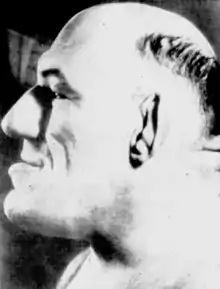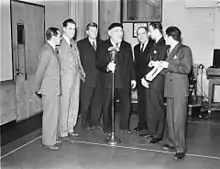The French Angel
Maurice Tillet (October 23, 1903 – September 4, 1954) was a French professional wrestler, better known by his ring name, The French Angel. Tillet was a leading box office draw in the early 1940s and was twice World Heavyweight Champion by the American Wrestling Association run by Paul Bowser in Boston.
| The French Angel | |
|---|---|
 Tillet in 1940 | |
| Birth name | Maurice Tillet |
| Born | October 23, 1903 Ural Mountains, Russian Empire |
| Died | September 4, 1954 (aged 50) Chicago, Illinois, U.S.[1] |
| Professional wrestling career | |
| Ring name(s) | The French Angel World's Ugliest Man[2] |
| Billed height | 1.75 m (5 ft 9 in)[1] |
| Billed weight | 122 kg (270 lb)[1] |
| Trained by | Karl Pojello |
| Debut | 1937 |
| Retired | 1953 |
Early life
Tillet was born in 1903 in the Ural Mountains in Russia to French parents.[1] His mother was a teacher and his father was a railroad engineer. Tillet's father died when he was young. As a child, he had a completely normal appearance and Tillet was nicknamed "The Angel" due to his angelic face. In 1917, Tillet and his mother left Russia due to the Revolution and moved to France, where they settled in Reims. When Tillet was 20, he noticed swelling in his feet, hands, and head, and after visiting a doctor was diagnosed with acromegaly—a condition usually caused by a benign tumor on the pituitary gland, resulting in bone overgrowth and thickening.[1]
He had wanted to become a lawyer, but his acromegaly prevented him from doing so. Tillet served in the French Navy for five years as an engineer.[1]
Professional wrestling career


In February 1937, Tillet met Karl Pojello (Lithuanian Karolis Požėla) in Singapore. Pojello was a professional wrestler, and convinced Tillet to enter the business. Tillet and Pojello moved to Paris for training, and Tillet wrestled for two years in France and England until World War II forced them to leave for the United States in 1939.[1]
In Boston, Massachusetts, in 1940, promoter Paul Bowser pushed Tillet, who was wrestling as The French Angel, as a main eventer, and he became a large draw in the area. As a result of his popularity, Tillet was booked as unstoppable, and was unbeaten for a span of 19 consecutive months. Tillet was the AWA World Heavyweight Champion from May 1940 until May 1942. He re-appeared with the Boston-based title for a short time in 1944.[1]
As a result of his success, several Angel imitators emerged, including Paul Olaffsen (Swedish Angel), who also had acromegaly; Tony Angelo (Russian Angel), Tor Johnson (Super Swedish Angel), Jack Rush (Canadian Angel), Wladislaw Tulin (Polish Angel), Stan Pinto (Czech Angel), Clive Welsh (Irish Angel), Jack Falk (Golden Angel), Gil Guerrero (Black Angel), and Jean Noble (Lady Angel). Tillet competed against Tor Johnson, who was billed as The Swedish Angel on those occasions.[1]
.jpg.webp)
By 1945, Tillet's health began to fail and he was no longer advertised as unstoppable. In his final wrestling match, in Singapore on February 14, 1953, working The National Wrestling Alliance Mid South Area then known as Tri-State and owned by Leroy McGuirk he agreed to lose to Bert Assirati.[1]
In 1950, Chicago sculptor Louis Linck befriended Tillet and made a series of plaster busts commemorating him for his wrestling career. One of the busts is in Chicago’s International Museum of Surgical Science. Another is now in the personal collection of Bruce Prichard.
Death
Tillet died on September 4, 1954, in Chicago, from cardiovascular disease after hearing of his trainer's passing.[1] Tillet is buried at the Lithuanian National Cemetery in Justice, Illinois, Cook County, 20 miles (32 km) south of Chicago.
Influence
Some have speculated that Maurice's appearance and behaviour inspired the likeness of the main character in the DreamWorks film Shrek (2001) of the same name, but this rumor has not been confirmed.[3]
Championships and accomplishments
- American Wrestling Association (Boston)
- AWA World Heavyweight Championship[4][5] (2 times)
- Professional Wrestling Hall of Fame
- Class of 2012[1]
References
- Oliver, Greg (December 14, 2011). "The French Angel was more man than monster". Slam! Sports. Canadian Online Explorer. Retrieved February 11, 2012.
- "Maurice Tillet". IMDb.
- Grenoble, Ryan (December 29, 2014). "Meet Maurice Tillet, The Man Rumored To Have Inspired Shrek". HuffPost. Retrieved April 23, 2019.
- "American Wrestling Association World Heavyweight Title [Boston]".
- "Title Lineages: AWA (Boston) World Heavyweight Championship".
Bibliography
- Parker, Mike. The World's Most Fantastic Freaks (1983). ISBN 0-7064-2145-0.
External links
| Wikimedia Commons has media related to Maurice Tillet. |
